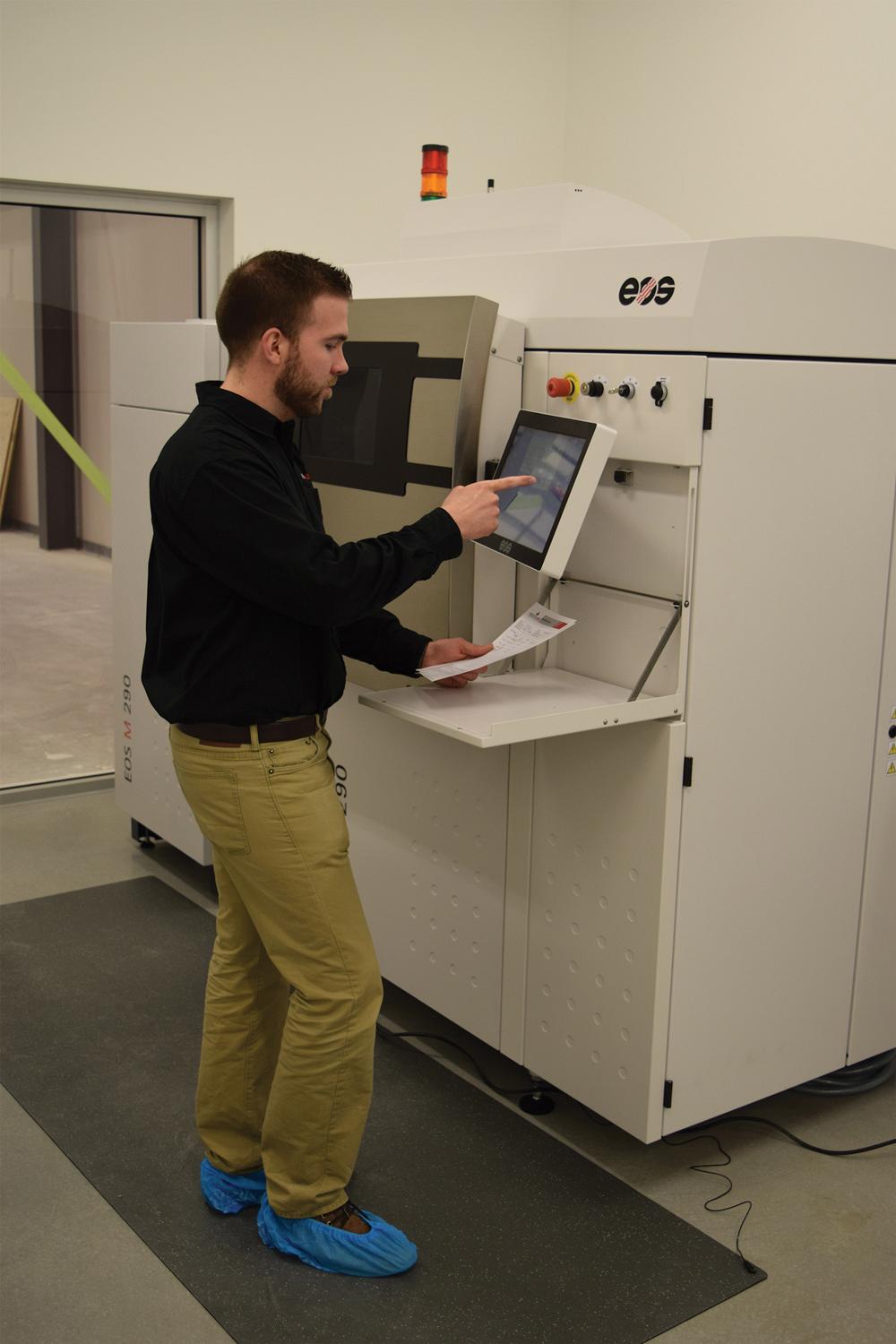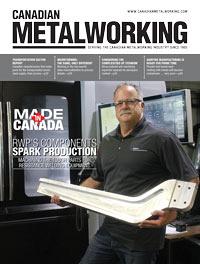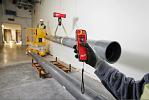Editor
- FMA
- The Fabricator
- FABTECH
- Canadian Metalworking
Additive Flexibility Key at Precision ADM
Winnipeg startup has equipped itself to meet the needs of a broad spectrum of clients
- By Rob Colman
- August 1, 2016
- Article
- Metalworking

Matthew Gale, manager of application engineering, uses the company’s EOS additive manufacturing to complement their subtractive machining processes.
The growth of the additive manufacturing (AM) market is creating a variety of business interests. Some established machine shops are diversifying their value proposition by branching out into this newer technology. In other cases, companies with design expertise and connections in the medical community are branching out into the field and attracting machining talent to support the move. Precision ADM is representative of this latter approach.
Precision ADM™ Inc. (PADM) is a start-p company owned by the Orthopaedic Innovation Centre (OIC), Winnipeg. PADM was incorporated in May 2015 and, until recently, operated out of the OIC facilities. It was created to identify, develop, and manufacture high-value components and devices for the medical, aerospace, energy, and industrial sectors.
Parent company OIC first got involved in 3-D printing more than five years ago when, using a Stratasys 3-D printer, it created a kneecap for a dog made from polymers. The company actually created a material that can be 3-D printed and that elutes a drug that can fight knee infection in patients.
This type of work is what OIC was created to do – create medical devices that can be applied at Winnipeg’s Concordia Hip & Knee Institute, the facility at which OIC resides. PADM, while an independent entity, takes that vision in new directions and opens up new opportunities.
Rapid Prototyping and Manufacturing
The CEO of both OIC and PADM, Martin Petrak, has created a team around him that has a blend of experience and youth. COO Jim Bartel could be considered a linchpin in terms of experience. Prior to joining PADM, he served as senior vice president at Stratasys Direct Manufacturing, one of the world’s largest providers of rapid prototyping and AM services.
Meantime, much of the rest of the team who are hands-on in the PADM shop are young ambassadors for this new market
“There are currently eight team members working out of our new facility, and we have some support staff at the OIC offices,” said Matthew Gale, manager of application engineering for PADM. Gale is a former tool designer in the aerospace sector whose CAD modeling skills have been key for his transition into this new technology.
A key partner for him on the additive side of the business is Jared Kozub. Kozub has a background as a mechanical design engineer in R&D and product development in the medical device and manufacturing industries.

Precision ADM Manufacturing Technician Clayton Pollock uses the company’s Nakamura-Tome NTRX-300 to perform true 5-axis milling.
Another key partner on the additive side has been their supplier, EOS, from which PADM bought two M 290 metal additive machines just over a year ago.
“EOS has done a lot to help us flatten out the learning curve with the metal additive technology,” said Gale. “We learned something every time we’ve built a new part.”
The choice of EOS came down to the versatility of the machine, the quality of the builds possible before finishing, the variety of materials available for use in the machine, and the installed base already in operation across North America.
“We felt they also had the best service structure to support us,” said Gale.
Having two additive machines was an important stipulation for PADM right from the beginning. One machine is dedicated to the building of titanium parts for use in medical and aerospace applications. The second machine is used for nickel alloys, including cobalt chrome, stainless steel, and maraging steel.
“For medical use, we can’t risk having builds contaminated by nickel alloys,” said Gale. “And the medical device market is a key opportunity for this technology. Patient-specific applications – single builds used to replace a hip or a knee joint – that can be customized for the individual is the sort of revolutionary application to which we hope to dedicate that machine.”
Gale, Kozub, and their team still feel they are on a steep learning curve with the metal applications of AM, having first learned their building techniques using polymers at OIC.
“It’s essentially a microwelding process, welding the part layer by layer,” Kozub said. “If you don’t have the part supported properly, or designed such that it can be built without supports, it may rip off the plate from the residual stresses caused by the welding. These interesting design challenges become easier to manage by learning from every build, but there’s still a lot to learn about this new technology.”
Thus far PADM has done work in numerous industries, including prototypes for medical device components, aerospace parts, injection moulds, and other industrial applications.
The value that PADM feels it brings to the market is being an end-to-end parts provider, from design to finishing.
“When we are looking at a job, we sit down and say, ‘We can orient it in this way on the build plate and create tooling tabs so it can easily be transferred to our 5-axis mill/turn machine,’” explained Jonathan Maes, manager of subtractive manufacturing. Maes has worked on designing, building, and programming CNC machining fixtures since 2007.
PADM’s mill/turn machine is a Nakamura-Tome NTRX-300, which has a maximum turning diameter of 640 mm, a maximum turning length of 1,150 mm, Y-axis travel of 250 mm (+/- 125 mm), and a B axis capable of 225 degrees (-120 degrees + 105) motion.
“The nice thing about that particular machine is that it has true 5-axis milling capabilities with a pretty decent window in which that is possible,” Maes explained. “I’ve got a 10-in. window in which I can do straight milling, which is a perfect complement to the EOS machines, which build on a 10- by 10- by 11¼-in. plate. It’s versatile because I can also do turning. Once we start doing more work in medical applications like hip cups, that will be crucial.
“Also, having a subspindle really makes it a one-and-done machine,” he continued. “As we grow we will likely acquire more specialized machine tools, but this is the ideal machine to start with in an additive-heavy environment.”
The whole PADM team agrees that it isn’t one technology or another that makes a great shop, it’s the part that is completed at the end of whatever process is used.
“Subtractive is crucial to our whole process,” said Kozub. “Additive is just a single tool in making advanced parts. We want to pick the right tools for the job and let them complement each other.”
Perhaps the biggest challenge for the PADM team right now is separating the real clients from those who are just keen to test-run the additive technology.
“Many times the parts that people bring us to print were designed to be made using traditional methods like machining. It may not make sense economically to just print these parts. However, it might make sense if thought is given upfront to see what new benefits printing can bring, like producing features that are too difficult to make otherwise,” said Kozub. “Our biggest hurdle is educating our customers so they understand how we can best add value for them. There is a lot of discussion with clients right now. The best time for us to meet them is right at the idea stage, unless they already understand the benefits and limitations of additive manufacturing. People understand the CNC machining world, but additive is still relatively new.”
With two additive machines, a 5-axis mill/turn machine and GF CUT 30 P submerged wire EDM, Precision ADM is well-equipped to tackle this burgeoning approach to manufacturing.
Contributing Editor Robert Colman can be reached at rcolman@canadianfabweld.com.
Precision ADM, 855-500-7236, www.precisionadm.com
Elliott Matsuura Canada, 905-829-2211, www.elliottmachinery.com
EOS, 248-306-0143, www.eos.info
About the Author

Rob Colman
1154 Warden Avenue
Toronto, M1R 0A1 Canada
905-235-0471
Robert Colman has worked as a writer and editor for more than 25 years, covering the needs of a variety of trades. He has been dedicated to the metalworking industry for the past 13 years, serving as editor for Metalworking Production & Purchasing (MP&P) and, since January 2016, the editor of Canadian Fabricating & Welding. He graduated with a B.A. degree from McGill University and a Master’s degree from UBC.
subscribe now


Keep up to date with the latest news, events, and technology for all things metal from our pair of monthly magazines written specifically for Canadian manufacturers!
Start Your Free Subscription- Industry Events
ZEISS Quality Innovation Days 2024
- April 15 - 19, 2024
Tube 2024
- April 15 - 19, 2024
- Düsseldorf, Germany
CTMA Economic Uncertainty: Helping You Navigate Windsor Seminar
- April 30, 2024
- Windsor, ON Canada
MME Winnipeg
- April 30, 2024
- Winnipeg, ON Canada
CTMA Economic Uncertainty: Helping You Navigate Kitchener Seminar
- May 2, 2024
- Kitchener, ON Canada




















